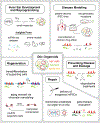Advancements in inner ear development, regeneration, and repair through otic organoids
- PMID: 35853286
- PMCID: PMC10425989
- DOI: 10.1016/j.gde.2022.101954
Advancements in inner ear development, regeneration, and repair through otic organoids
Abstract
The vertebrate inner ear contains a diversity of unique cell types arranged in a particularly complex 3D cytoarchitecture. Both of these features are integral to the proper development, function, and maintenance of hearing and balance. Since the elucidation of the timing and delivery of signaling molecules to produce inner ear sensory cells, supporting cells, and neurons from human induced pluripotent stem cells, we have entered a revolution using organ-like 'otic organoid' cultures to explore inner ear specific genetic programs, developmental rules, and potential therapeutics. This review aims to highlight a selection of reviews and primary research papers from the past two years of particular merit that use otic organoids to investigate the broadly defined topics of cell reprogramming, regeneration, and repair.
Copyright © 2022 The Author(s). Published by Elsevier Ltd.. All rights reserved.
Figures

Similar articles
-
Directed Differentiation of Human Pluripotent Stem Cells into Inner Ear Organoids.Methods Mol Biol. 2022;2520:135-150. doi: 10.1007/7651_2021_448. Methods Mol Biol. 2022. PMID: 34724191
-
From Otic Induction to Hair Cell Production: Pax2EGFP Cell Line Illuminates Key Stages of Development in Mouse Inner Ear Organoid Model.Stem Cells Dev. 2018 Feb 15;27(4):237-251. doi: 10.1089/scd.2017.0142. Epub 2018 Jan 29. Stem Cells Dev. 2018. PMID: 29272992 Free PMC article.
-
Generation of inner ear organoids containing functional hair cells from human pluripotent stem cells.Nat Biotechnol. 2017 Jun;35(6):583-589. doi: 10.1038/nbt.3840. Epub 2017 May 1. Nat Biotechnol. 2017. PMID: 28459451 Free PMC article.
-
Building inner ears: recent advances and future challenges for in vitro organoid systems.Cell Death Differ. 2021 Jan;28(1):24-34. doi: 10.1038/s41418-020-00678-8. Epub 2020 Dec 14. Cell Death Differ. 2021. PMID: 33318601 Free PMC article. Review.
-
Cellular diversity of human inner ear organoids revealed by single-cell transcriptomics.Development. 2024 Dec 1;151(23):dev202524. doi: 10.1242/dev.202524. Epub 2024 Nov 29. Development. 2024. PMID: 39612289 Review.
Cited by
-
Shared features in ear and kidney development - implications for oto-renal syndromes.Dis Model Mech. 2024 Feb 1;17(2):dmm050447. doi: 10.1242/dmm.050447. Epub 2024 Feb 14. Dis Model Mech. 2024. PMID: 38353121 Free PMC article.
-
[Organoids-the key to novel therapies for the inner ear? German version].HNO. 2023 Nov;71(11):702-707. doi: 10.1007/s00106-023-01366-y. Epub 2023 Oct 16. HNO. 2023. PMID: 37845538 Review. German.
-
Hair cell toxicology: With the help of a little fish.Front Cell Dev Biol. 2022 Dec 13;10:1085225. doi: 10.3389/fcell.2022.1085225. eCollection 2022. Front Cell Dev Biol. 2022. PMID: 36582469 Free PMC article. Review.
-
The Role of Pericytes in Inner Ear Disorders: A Comprehensive Review.Biology (Basel). 2024 Oct 8;13(10):802. doi: 10.3390/biology13100802. Biology (Basel). 2024. PMID: 39452111 Free PMC article. Review.
-
Modeling, applications and challenges of inner ear organoid.Smart Med. 2024 Jan 16;3(1):e20230028. doi: 10.1002/SMMD.20230028. eCollection 2024 Feb. Smart Med. 2024. PMID: 39188517 Free PMC article. Review.
References
-
- Naples JG, Ruckenstein MJ: Cochlear Implant. Otolaryng Clin N Am 2019, 53:87–102. - PubMed
Publication types
MeSH terms
Grants and funding
LinkOut - more resources
Full Text Sources
Miscellaneous

